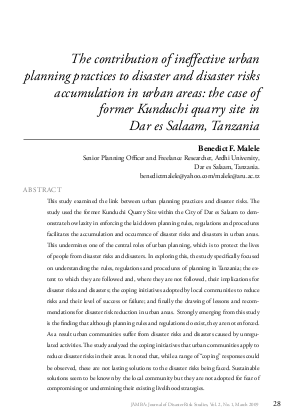
This study examined the link between urban planning practices and disaster risks. The study used the former Kunduchi Quarry Site within the City of Dar es Salaam to demonstrate how laxity in enforcing the laid down planning rules, regulations and procedures facilitates the accumulation and occurrence of disaster risks and disasters in urban areas. This undermines one of the central roles of urban planning, which is to protect the lives of people from disaster risks and disasters. In exploring this, the study specifically focused on understanding the rules, regulations and procedures of planning in Tanzania; the extent to which they are followed and, where they are not followed, their implications for disaster risks and disasters; the coping initiatives adopted by local communities to reduce risks and their level of success or failure; and finally the drawing of lessons and recommendations for disaster risk reduction in urban areas. Strongly emerging from this study is the finding that although planning rules and regulations do exist, they are not enforced. As a result urban communities suffer from disaster risks and disasters caused by unregulated activities. The study analyzed the coping initiatives that urban communities apply to reduce disaster risks in their areas. It noted that, while a range of “coping” responses could be observed, these are not lasting solutions to the disaster risks being faced. Sustainable solutions seem to be known by the local community but they are not adopted for fear of compromising or undermining their existing livelihood strategies.
Links
Resource collections
- UN Habitat - Urban Response Collection
- Urban Response - Urban Crisis Preparedness and Risk Reduction
- Urban Response Collection - Community Engagement and Social Cohesion
- Urban Response Collection - Economic Recovery
- Urban Response Collection - Environment and Climate Change
- Urban Response Collection - Housing, Land and Property
- Urban Response Collection - Urban Crisis Response, Recovery and Reconstruction
- Urban Response Collection - Urban Resilience